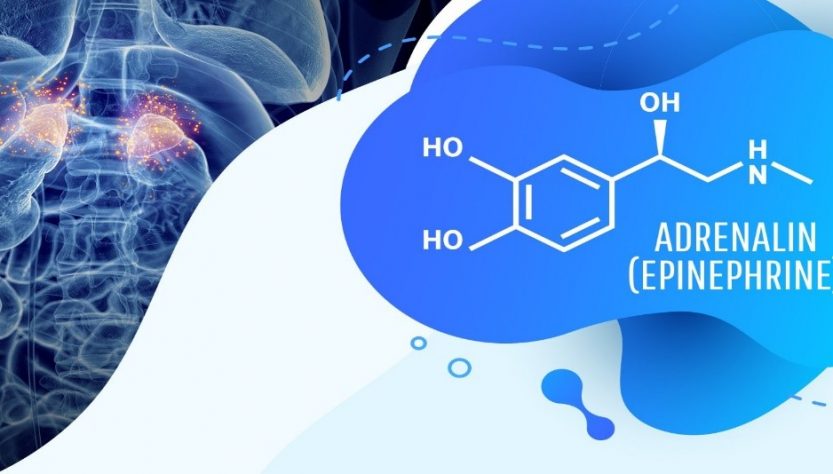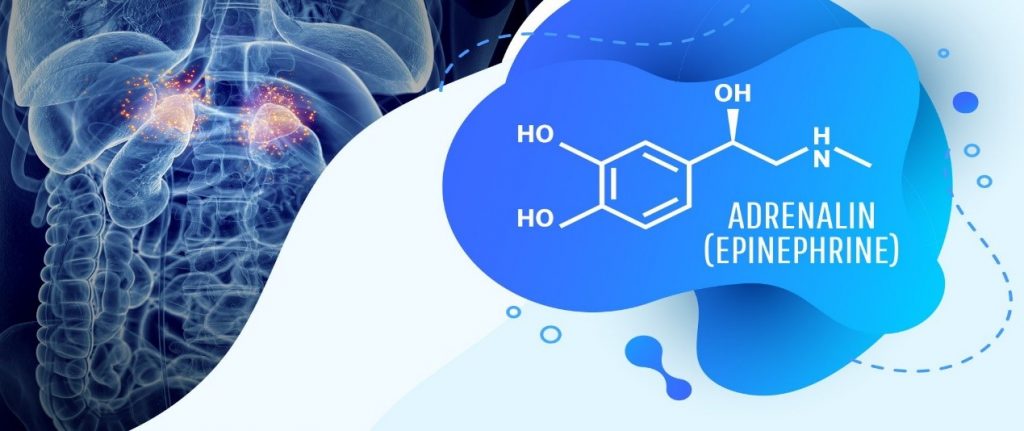Prepared by: Eman Ezzadin Abdulrahman
2nd Grade, Faculty of Pharmacy
Epinephrine, more commonly known as adrenaline, is a hormone secreted by the medulla of the adrenal glands. Strong emotions such as fear or anger cause epinephrine to be released into the bloodstream means when there is a situation this hormone will be secreted, which causes an increase in heart rate, muscle strength, blood pressure, and sugar metabolism. This reaction, known as the “Flight or Fight Response” prepares the body for strenuous activity.
Epinephrine is closely related in structure to norepinephrine, differing only in the presence of a methyl group on the nitrogen side chain. In both substances, the amine (nitrogen-containing) group is attached to a catechol group (a benzene ring with two hydroxyl groups)—a structure unique to the catecholamines. Both substances are key stimulatory components of the sympathetic nervous system (part of the autonomic nervous system). But as it was said, they are different in a methyl group on the nitrogen.
Epinephrine is produced specifically in the adrenal medulla, where the amino acid tyrosine is transformed through a series of reactions to norepinephrine, means epinephrine is formed by actioning some reactions on norepinephrine . An enzyme known as phenylethanolamine N-methyltransferase, which is found in the chromaffin cells of the adrenal medulla, catalyzes the methylation of norepinephrine to epinephrine.
The normal range for epinephrine is 0 to 140 pg/mL (764.3 pmol/L). The normal range for norepinephrine is 70 to 1700 pg/mL (413.8 to 10048.7 pmol/L).
The normal range of epinephrine in the urine during the urine test which also varies slightly depending on the lab are:
For the 24-hour urine test, values below 20 mcg/24h are considered normal.
For the random urine test, values below 19 mcg/g are considered normal.
The Secretion of Epinephrine or Adrenaline:
Mainly stress engages sympathetic arousal, which stimulates the medulla of the adrenal glands. Epinephrine is stored in electron-dense granules which also contain ATP and several neuropeptides. Secretion of these hormones is stimulated by acetylcholine release from preganglionic sympathetic fibers innervating the medulla. Adrenaline or epinephrine is released mainly through the activation of nerves connected to the adrenal glands, which trigger the secretion of adrenaline and thus increase the level of adrenaline in the blood. This process happens relatively quickly, within 2 to 3 minutes of the stressful event being encountered. Also, when is secreted, Epinephrine functions primarily to increase cardiac output and to raise glucose levels in the blood.
The Target Organ of Epinephrine:
Hormones are chemical messengers secreted into the circulation by an endocrine gland. It is carried by the blood stream to target cells which contain receptors for the particular message. Epinephrine hormone will act on most cells in the body prolonging and intensifying the sympathetic nervous system response to stress. The mechanism of action of epinephrine starts by action on alpha-1 receptors, epinephrine induces increased vascular smooth muscle contraction, pupillary dilator muscle contraction, and intestinal sphincter muscle contraction.
Use of Epinephrine:
Epinephrine should be used immediately if you experience severe symptoms such as shortness of breath, repetitive coughing, weak pulse, generalized hives, tightness in the throat, trouble breathing/swallowing, or a combination of symptoms from different body areas such as hives, rashes, or swelling on the skin. This medication (Epinephrine Injection) is used in emergencies to treat very serious allergic reactions to insect stings/bites, foods, drugs, or other substances. Other uses of epinephrine include:
- Asthma attacks.An inhaled form of epinephrine can help treat or prevent severe asthma attacks.
- Cardiac arrest.An epinephrine injection may restart your heart if your heart has stopped pumping (cardiac arrest).
- If you have a severe infection and aren’t producing enough catecholamines, you may need to be given epinephrine through an intravenous line (IV).
- Anesthesia. Adding epinephrine to local anestheticscan make them last longer.
Possible Side Effects of Epinephrine Injection:
- Breathing problems;
- Fast or pounding heartbeats;
- Pale skin, sweating;
- Nausea and vomiting;
- Dizziness;
- Weakness or tremors;
- Throbbing headache;
- Feeling nervous, anxious, or fearful.
Symptoms of Epinephrine Rush:
- Rapid heart rate;
- Sweating;
- Heightened senses;
- Rapid breathing;
- Decreased ability to feel pain;
- Increased strength and performance;
- Dilated pupils;
- Feeling jittery or nervous.
Symptoms of Low Epinephrine:
- Anxiety;
- Depression;
- Changes in blood pressure;
- Changes in heart rate;
- Low blood sugar, or hypoglycemia;
- Migraine headaches;
- Sleeping problems.
References:
Epinephrine – StatPearls – NCBI Bookshelf.
https://ncbi.nlm.nih.gov › books › NBK482160
EPINEPHRINE injection, solution – DailyMed
https://dailymed.nlm.nih.gov › dailymed › drugInfo
Catecholamine blood test: MedlinePlus Medical Encyclopedia
https://medlineplus.gov › Medical Encyclopedia
epinephrine injection | Michigan Medicine
https://uofmhealth.org › health-library
Epinephrine vs. norepinephrine: Differences, functions, and …
https://medicalnewstoday.com › articles
Epinephrine Intramuscular: Uses, Side Effects, Interactions .https://webmd.com › drugs › drug-93171 › details



